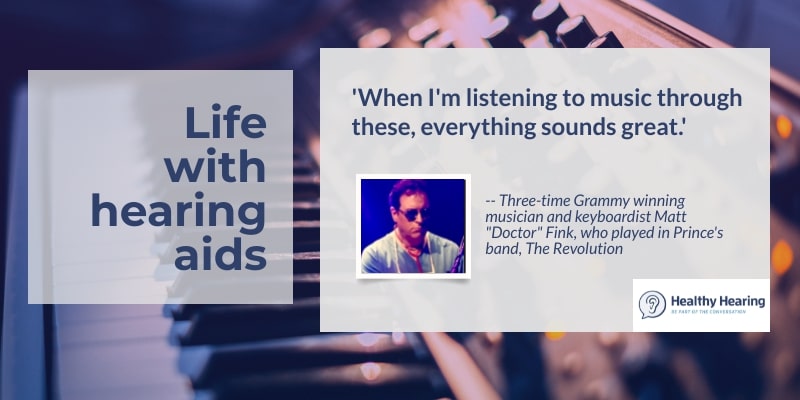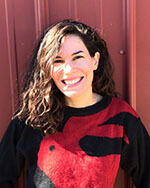|
www.HealthyHearing.com |
Prince's longtime keyboardist shares journey to hearing aidsHearing aids with wide dynamic range were key to helping 'Dr. Fink' hear better, his clinician says
Contributed by Madeleine Burry Dr. Fink is no medical doctor. Rather, Matt Fink, 64, got that moniker when he played keyboards with Prince’s band, The Revolution, starting in 1978—he appeared on stage clad in scrubs and surgical mask, sometimes donning a stethoscope to round out his alter ego. Here’s the thing to know about being in The Revolution: “Back in the day with Prince, they didn't really have any in-ear monitors invented yet,” Fink recalls. And once in-ear monitors—which deliver the on-stage mix directly into musicians’ ears—were around in the late 1980s or ‘90s, Prince “didn't want to use them,” Fink says. The result: “It was loud on stage."
Big speakers occupied both sides of the stage, and Fink had wedge speakers near him, which he tried to keep at a reasonable level. But Prince “would just blast and wash the stage with the big speakers, and you literally felt the bottom bass hitting your chest,” Fink says. Sometimes when the set was done, Fink noticed the effect in his ears: muffled, echoing sounds, or persistent ringing. “It definitely was wearing and tearing on the hearing mechanism in there,” Fink says. “But, you know, I couldn’t tell him [Prince] what to do because he was my boss.” Fink, a three-time Grammy winner, has been playing since he was around 13 years old. Now, he’s back with The Revolution (which reunited after Prince’s death) and works in the studio as a producer and engineer. He had a few decades—starting in the 1990s, after his time with The Revolution, and through the early 2000s—when he was away from working as a live musician, and focused on production. “I've been playing with some other people lately for fun,” Fink says—for the most part, everyone he’s working with is using custom, in-ear monitors that are molded to fit musicians’ ears and allow for the right levels on stage, he says. Getting fitted for hearing aidsIn around 2015 or so, Fink realized he needed hearing aids. Like many, he didn’t follow up with an appointment right away. “I also find that other musicians I know who are in dire need of hearing aids are not getting them yet,” Fink says. For musicians—who depend on their hearing—hearing loss is particularly worrisome and stress-inducing. “Especially when you hear about people like Huey Lewis, who can't perform because of their hearing issues,” Fink notes. (Lewis has Meniere’s disease, and has difficulty hearing certain frequencies.) The first step, of course, is an appointment. That’s around when Fink met hearing instrument specialist Debbie Miller (Miller now works for Healthy Hearing). “As a musician, it's important how he hears music,” Miller says. She recommended that he try a pair of hearing aids that she knew offered sounds that were “so dynamic and just so full”—some hearing aids, she notes, may allow you to hear but have a more tinny sound. “I like to use the reference that you're listening to music through a transistor radio, as opposed to a nice full stereo system,” Miller says. Months after Fink’s fitting, she went to see him perform with The Revolution, up in St. Cloud, Minnesota. “And they’re loud. It’s really, really loud,” Miller says, remembering that she used the decibel reader on her phone. Year after year of that level of noise exposure would inevitably lead to the musicians’ experiencing hearing loss, she says. Life with hearing aidsFink’s hearing aids are a huge success. “I hear really well,” Fink says. With the hearing aids in, “I don’t have many issues with conversation [or with] listening to the television or radio,” Fink says. And he’s able to wear his hearing aids in the studio, mixing songs. There are some differences: “If I’m in my studio here mixing songs, I can’t listen at low levels anymore,” he says. If he does, high frequency sounds—like high hats and vowel sounds—go away, he says. Hearing aids work to equalize sound, which can be less than ideal for musicians, Miller notes. “I mix with my hearing aids in,” Fink says—sometimes, he sends the files out to other engineers with intact hearing to double-check his mixes. When “I'm listening to music through these everything sounds great,” Fink says. How musicians can safeguard their hearingBe smart about monitors
should be aware of sound levels and protect their hearing if it's too loud. It’s too often the old “turn it up to 11” scenario when it comes to monitors. “It’s like a battle on stage and people don’t even realize it’s going on,” Miller says. “Everyone’s ears are suffering.” Fink recalls a stretch of time, from 2012 to 2016, when the bass player sat beside him with his amp, playing loudly much of the time. “I begged him... you don’t need to be that loud on stage,” Fink says. (The audience hears from speakers facing the crowd; on-stage monitors’ are for musicians’ benefit.) But the musician persisted. “I think I incurred more damage being next to him,” Fink says. Monitors don’t need to be that loud, Miller points out. They’re there to allow you to “hear the big picture,” she says. But what often happens is that one player turns up their sound—and then the other musicians on stage can’t hear themselves. So first the bass gets loud, then the guitar, then the keyboard... and then maybe the bass goes a notch higher in response. If possible, opt for in-ear monitors. They can be an adjustment. “I find it took awhile to get used to,” Fink says. “But it is way better for your hearing,” he adds. Consider earplugsFor musicians, the thought of wearing earplugs when listening to music can be unappealing. But some earplugs are designed specifically for music-lovers, and allow sound fidelity but lower decibels. If you’re listening to the opener, or staying after your own set, you can pop in earplugs and safeguard your hearing. More: What musicians need to know about hearing protection Be aware of noise levelsStay cognizant of noise levels. You can easily purchase or download a decibel reader. And remember that three things factor into determining if something is too loud: how loud it is, how long the noise lasts, and how close you were to it. If you feel your hearing is "off" after an event, you may have temporary threshold shift. One loud concert isn’t necessarily a problem—night after night of high volumes though, can add up to damage. Taking the first step is often the hardestWhen you make an appointment to get fitted for hearing aids, tell your clinician about your history, and also all about your current lifestyle and passions. Hearing aids are dynamic, not cookie-cutter products—it can take several rounds of tweaking and visits to get the program right, Miller says. Your provider can also add a music setting for your hearing aids, which may also help you with tinnitus, a common problem among musicians. And while you can’t capture the way you heard sounds in your twenties, you can work to hear what’s important to you, whether it’s the soft frisson as you slide your finger along an acoustic guitar or the tweets of birds at the feeder. “You need to have a relationship with your clinician,” Miller says. And then, keep going back until the sounds are right and fit your life situation and priorities. Madeleine Burry
Related Help Pages:
Hearing aids Bluetooth Fitting Cleaning Batteries Accessories Cochlear implants Bone-anchored hearing systems
|
Featured clinics near me
Earzlink Hearing Care - Reynoldsburg
7668 Slate Ridge Blvd
Reynoldsburg, OH 43068

Find a clinic
We have more hearing clinic reviews than any other site!



 Madeleine Burry is a Brooklyn-based freelance writer and editor. She's written about health for several online publications, including Women's Health, Prevention, Health, Livestrong and Good Housekeeping. You can follow her on Twitter @lovelanewest.
Madeleine Burry is a Brooklyn-based freelance writer and editor. She's written about health for several online publications, including Women's Health, Prevention, Health, Livestrong and Good Housekeeping. You can follow her on Twitter @lovelanewest.